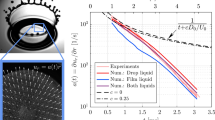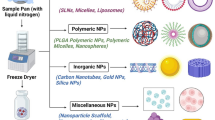Purpose
The aim of this study was to develop a rheological method to evaluate the stability of highly viscous pharmaceutical emulsions. Thereby, the time devoted to the storage tests could be reduced and manufacturers could save time in optimizing their formulations and manufacturing techniques for topical pharmaceutical forms. The influence of the type of oil and the type of emulsifier on the microstructure of the emulsions was also studied.
Materials and Methods
The samples were stored at 25 and at 50°C for 6 months and analysed every month using rheological as well as microscopic techniques. The size and the organization of the droplets within the emulsion were determined by freeze-fracture electron microscopy and optical contrast phase microscopy.
Results
A decrease in the rheological parameters was observed for the OC emulsions (“Tween/Span” emulsions made with olive oil) and the “Montanov” emulsions. The rheological measurements showed that the structure of the OC emulsions and that of the emulsions made with the Montanov 82 emulsifier become more brittle when submitted to a shear force. The micrographs obtained by freeze-fracture electron microscopy showed that for OC only the oil droplets arrange in a network structure. Storage tests at 50°C confirmed the rheological assumptions on the stability of emulsions.
Conclusion
The study of the effect of shearing on the emulsions allowed quick discrimination between the emulsions according to their stabilities. The rheological tool gave information on the structure of the emulsions and on the aging process.









Similar content being viewed by others
References
A. T. Florence and F. Rieg. L'instabilité des émulsions. In: F. Puissieux and M. Seiller (eds.), Agents de Surface et Émulsions: Les Systèmes Dispersés I. Lavoisier, Tec & Doc, Paris, 1983, pp. 321–342, (Galenica 5 vol. 5).
R. P. Borwankar, L. A. Lobo, and D. T. Wasan. Emulsion stability—kinetics of flocculation and coalescence. Colloids Surf. 69:135–146 (1992).
E. Dickinson. Les Colloïdes Alimentaires. Masson, Paris, 1992, pp. 85–121.
P. C. Hiemenz and R. Rajagopalan. Principles of Colloid and Surface Chemistry, 3rd ed. Dekker, New York, 1997.
J. Mewis and J. H. Macosko. Rheology: Principles, Measurements and Applications. VCH, New York, 1994, Chapter 10.
T. F. Tadros. Fundamental principles of emulsion rheology and their applications. Colloids Surf. A: Physicochem. Eng. Asp. 91:39–55 (1994).
R. Pal. Effect of droplet size on the rheology of emulsions. AIChE J. 42:3181–3190 (1996).
H. A Barnes. Rheology of emulsions—a review. Colloids Surf. A: Physicochem. Eng. Asp. 91:89–95 (1994).
T. F. Tadros. Correlation of viscoelastic properties of stable and flocculated suspensions with their interparticle interactions. Adv. Colloid Interface Sci. 68:97–200 (1996).
T. G. Mason. New fundamental concepts in emulsion rheology. Curr. Opin. Colloid Interface Sci. 4:231–238 (1999).
R. Chanamai and D. J. McClements. Dependence of creaming and rheology of monodisperse oil-in-water emulsions on droplet size and concentration. Colloids Surf. A: Physicochem. Eng. Asp. 172:79–86 (2000).
I. Terrisse, M. Seiller, A. Rabaron, J. L. Grossiord, A. Magnet, and C. Le Hen-Ferrenbach. Rheology: how to characterize and to predict the evolution of W/O/W multiple emulsions. Int. J. Cosmet. Sci. 15:53–62 (1993).
C. Py, J. Rouvière, P. Loll, M. C. Taelman, and T. F. Tadros. Investigation of multiple emulsion stability using rheological measurements. Colloids Surf. A: Physicochem. Eng. Asp. 91:215–225 (1994).
S. Tamburic. The aging of polymer-stabilized creams: a rheological viewpoint. Cosmet. Toiletries 15:43–49 (2000).
M. Korhonen, L. Hellen, J. Hirvonen, and J. Yliruusi. Rheological properties of creams with four different surfactant combinations—effect of storage time and conditions. Int. J. Pharm. 221:187–196 (2001).
V. Kontogiorgos, C. G. Biliaderis, V. Kiosseoglou, and G. Doxastakis. Stability and rheology of egg-yolk-stabilized concentrated emulsions containing cereal β-glucans of varying molecular size. Food Hydrocoll. 18:987–998 (2004).
H. Masmoudi, Y. Le Dréau, P. Piccerelle, and J. Kister. The evaluation of cosmetic and pharmaceutical emulsions aging process using classical techniques and a new method: FTIR. Int. J. Pharm. 289:117–131 (2005).
J. Roussos. Formulation des émulsions. In: F. Puissieux, M. Seiller (eds.), Agents de Surface et Émulsions: Les Systèmes Dispersés I. Lavoisier, Tec & Doc, Paris, 1983, pp. 407–421, (Galenica 5 vol. 5)
J. Surh, E. A. Decker, and D. J. McClements. Properties and stability of oil-in-water emulsions stabilized by fish gelatine. Food Hydrocoll. 20:596–606 (2006).
V. André, N. Willenbacher, H. Debus, L. Börger, P. Fernandez, T. Frechen, and J. Rieger. Prediction of emulsion stability: facts and myth. Cosmetics and Toiletries Manufacture Worldwide 102–109 (2003).
D. Vasiljevic, J. Parojcic, M. Primorac, and G. Vuleta. An investigation into the characteristics and drug release properties of multiple W/O/W emulsion systems containing low concentration of lipophilic polymeric emulsifier. Int. J. Pharm. 309:171–177 (2006).
P. B. Laxton and J. C. Berg. Gel trapping of dense colloids. J. Colloid Interface Sci. 285:152–157 (2005).
S. Savic, G. Valuta, R. Daniels, and C. C. Mueller-Goymann. Colloidal microstructure of binary systems and model creams stabilized with an alkylpolyglucoside non-ionic emulsifier. Colloid. Polym. Sci. 283:439–451 (2005).
L. Baudonnet, J. L. Grossiord, and F. Rodriguez. Physicochemical characterization and in vitro release of salicylic acid from O/W emulsions prepared with Montanov 68®: effect of formulation parameters. Drug Dev. Ind. Pharm. 30:975–984 (2004).
G. P. Roberts and H. A. Barnes. New measurements of the flow-curves for Carbopol dispersions without slip artefacts. Rheol. Acta. 40:499–503 (2001).
H. Zhu, Y. D. Kim, and D. De Kee. Non-Newtonian fluids with a yield stress. J. Non-Newtonian Fluid Mech. 129:177–181 (2005).
T. F. Tadros. Application of rheology for assessment and prediction of the long-term physical stability of emulsions. Adv. Colloid Interface Sci. 108–109:227–258 (2004).
N. G. Diftis, C. G. Biliaderis, and V. D. Kiosseoglou. Rheological properties and stability of model salad dressing emulsions prepared with a dry-heated soybean protein isolate-dextran mixture. Food Hydrocoll. 19:1025–1031 (2005).
T. Ó. Thorgeirsdóttir, A. L. Kjøniksen, K. D. Knudsen, T. Kristmundsdóttir, and B. Nyström. Viscoelastic and structural properties of pharmaceutical hydrogels containing monocaprin. Eur. J. Pharm. Biopharm. 59:333–342 (2005).
A. Paraskevopoulou, V. Kiosseoglou, S. Alevisopoulos, and S. Kasapis. Small deformation properties of model salad dressings prepared with reduced cholesterol egg yolk. J. Texture Stud. 28:221–237 (1997).
N. Jager-Lézer, J. F. Tranchant, V. Alard, C. Vu, P. C. Tchoreloff, and J. L. Grossiord. Rheological analysis of highly concentrated W/O emulsions. Rheol. Acta. 37:129–138 (1998).
G. K. Moates, A. D. Watson, and M. M. Robins. Creaming and oscillation rheology of weakly flocculated concentrated emulsions. Colloids Surf. A: Physicochem. Eng. Aspects. 190:167–178 (2001).
J. Dubochet, J. Lepault, R. Freeman, J. A. Berriman, and J. C. Homo. Electron microscopy of frozen water and aqueous solutions. J. Microscopy. 128:219–237 (1982).
J. A. Zasadzinski and S. M. Bailey. Applications of freeze-fracture replication to problems in materials and colloid science. J. Electron Microsc. Tech. 13:309–334 (1989).
E. Dumay, C. Lambert, S. Funtenberger, and J. C. Cheftel. Effects of high pressure on the physico-chemical characteristics of dairy creams and model oil/water emulsions. Lebensmittel-Wissenschaft und-Technologie. 29:606–625 (1996).
T. Sanz Taberner, A. Martín-Villodre, J. M. Pla-Delfina, and J. V. Herráez. Consistency of Carbopol 971-P NF gels and influence of soluble and cross-linked PVP. Int. J. Pharm. 233:43–50 (2002).
R. Barreiro-Iglesias, C. Alvarez-Lorenzo, and A. Concheiro. Poly(acrylic acid) microgels (carbopol® 934)/surfactant interactions in aqueous media: Part I: Nonionic surfactants. Int. J. Pharm. 258:165–177 (2003).
Author information
Authors and Affiliations
Corresponding author
Rights and permissions
About this article
Cite this article
Masmoudi, H., Piccerelle, P., Le Dréau, Y. et al. A Rheological Method to Evaluate the Physical Stability of Highly Viscous Pharmaceutical Oil-in-Water Emulsions. Pharm Res 23, 1937–1947 (2006). https://doi.org/10.1007/s11095-006-9038-x
Received:
Accepted:
Published:
Issue Date:
DOI: https://doi.org/10.1007/s11095-006-9038-x




